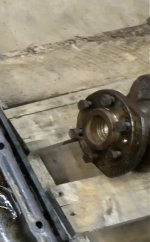Hello all,
I got my 1966 401 Nailhead back together and I'm starting to put the flex plate on. I noticed that it doesn't sit against the crank flange but rather rides on top of register, which I thought was odd. I don't recall what it looked like when I took it a part almost 2 years ago. One would assume the flex plate would want to rest fully on the crank flange and not be floating. The car was not running when I got it, but previously had been used until it sat for many years.
The crankshaft and flex plate are the same that came out of the car, I'm not swapping anything. I don't think the machine shop would have given me a different crank without telling me (or charging me).
As I torque the bolts down it pulls the flex plate in towards crank flange but that seems wrong. I know it's called a flex plate but pulling it in that far doesn't seem right. This is my first time dealing with an automatic/flexplate/torque converter etc so I'm not sure what to expect.
Normally you should be able to 'hang' the flex plate off the crank shaft before bolting it up right?. I can't do that.
Did someone mixup flex plates at somepoint? Please help!
Thank you,
Greg
I got my 1966 401 Nailhead back together and I'm starting to put the flex plate on. I noticed that it doesn't sit against the crank flange but rather rides on top of register, which I thought was odd. I don't recall what it looked like when I took it a part almost 2 years ago. One would assume the flex plate would want to rest fully on the crank flange and not be floating. The car was not running when I got it, but previously had been used until it sat for many years.
The crankshaft and flex plate are the same that came out of the car, I'm not swapping anything. I don't think the machine shop would have given me a different crank without telling me (or charging me).
As I torque the bolts down it pulls the flex plate in towards crank flange but that seems wrong. I know it's called a flex plate but pulling it in that far doesn't seem right. This is my first time dealing with an automatic/flexplate/torque converter etc so I'm not sure what to expect.
Normally you should be able to 'hang' the flex plate off the crank shaft before bolting it up right?. I can't do that.
Did someone mixup flex plates at somepoint? Please help!
Thank you,
Greg



